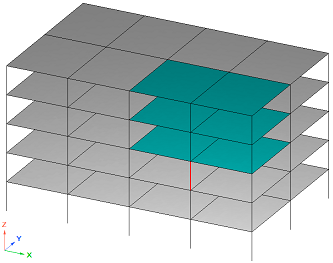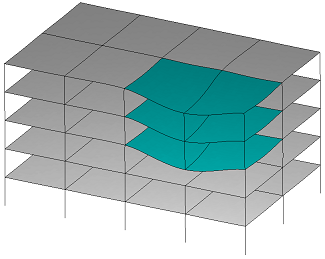

The "progressive collapse " concept refers to a situation when the failure or damage of any small part of the structure leads to a complete or nearly complete destruction of the whole structure. Emergencies can be caused by the human activities or by the natural phenomena. The first case includes gas explosions, terrorist attacks, fires, defects in design, construction, and maintenance of buildings, their unqualified reconstruction (with superstructures, extensions, replanning of premises), resulting in weakening or overloading the bearing elements and subgrade etc. Emergencies can be caused by such natural phenomena as earthquakes, hurricanes, landslides, non-uniform deformation of the subgrade.
Since it is impossible to completely eliminate the risk of emergencies or emergency impacts, it is necessary to provide a certain degree of safety of people in buildings and of their property by reducing the possibility of the progressive collapse at the local failures of load-bearing structures.
In order to prevent the progressive collapse the general strengthening, local strengthening, and interconnection between elements can be provided. Most US codes prefer the general strengthening when the failure of one of the elements of the building does not lead to the destruction of the whole structure. The local strengthening, i.e. strengthening of the most sensitive places, is very difficult to standardize for including in the design codes, since it is necessary to understand the nature of the possible actions on the building, including the terrorist attacks. Structural interconnections between the elements or the continuity of the structure are other methods of the general or local strengthening.
The main provisions of the current regulations for the prevention of progressive collapse can be given as follows:
The mode is implemented in SCAD in accordance with the current regulations and is designed to model the behavior of buildings and structures in the case of emergency impacts which caused the local failures of individual vertical load-bearing elements. The authors also took into account the apparent arbitrariness of the initial assumptions:
Structures cannot be completely free from the risk of collapse because of the uncertainties of the requirements to the system, dispersion of mechanical properties of building materials, difficulties of adequate modeling of the behavior of the system even when the modern software are used. Moreover, it is impossible to design and build an absolutely safe structure without taking into account the cost of the prevention of emergencies.
Thus, we can obtain a qualitative assessment of the stability characteristics of the structure with respect to the progressive collapse in the result of the numerical modeling, and compare several possible collapse scenarios in order to detect weak areas in the structure.
Currently, there are four known approaches to the progressive collapse analysis: static linear analysis, static nonlinear analysis, dynamic linear analysis and dynamic nonlinear analysis.
SCAD implements both quasi-static linear and nonlinear analysis methods using dynamic amplification factors, as well as direct dynamic linear and nonlinear analysis.
The progressive collapse analysis is based on the following provisions:
 |
 |
Figure 24-1. Primary and secondary design models
Progressive collapse analysis is performed in a quasi-static or dynamic formulation. The quasi-static formulation includes the following procedures:
Dynamic analysis is performed in the same way as the static one:
If the dynamic linear analysis is selected, and the secondary design model is geometrically stable, then the system experiences damped oscillations. In this case, it is necessary to monitor the values of forces in structural elements and, if in accordance with the accepted failure criteria, some elements fail, then they are removed from the design model.
If the dynamic nonlinear analysis is used, taking into account physical nonlinearity, then in the case of a progressive collapse, the oscillations of the control nodes of the design model increase unlimitedly. If the progressive collapse did not take place under the selected scenario, then the control nodes of the design model experience damping oscillations. When analyzing the accumulated damage in the finite elements, the designer must decide whether to strengthen the structure or consider its current condition as acceptable. When performing the nonlinear dynamic analysis, it is strongly recommended to take into account the geometric nonlinearity along with the physical nonlinearity.